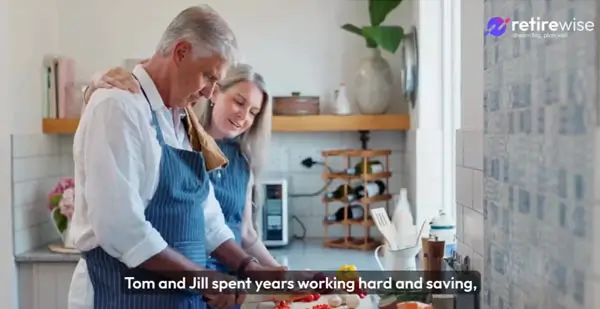Familiar Questions, Real Answers
When couples in their 50s or early 60s think about retirement, a few big questions usually come up:
- Do we have enough to retire?
- Should we keep or sell our investment property?
- How can we reduce tax and still grow our super?
- Will we qualify for the Age Pension?
These were exactly the questions Tom (62) and Jill (59) brought to Retirewise. Their goal? Retire in four years on an income of $100,000 a year.
Case Study: How Tom & Jill Grew Super 10x and Secured $100K Retirement Income
Their story is already featured on our Case Studies page, but in this blog we go deeper — unpacking the key financial lessons behind their choices so you can apply them to your own retirement plan.
Lesson 1: Property Isn’t Always the Best Retirement Asset
Tom and Jill owned an investment property worth around $700,000. At first glance, it seemed like a strong asset to hold into retirement. But here’s the problem:
- Rental income is fully taxable and counts in Centrelink’s income test.
- Property ties up wealth in an illiquid asset — you can’t easily draw on it for living costs.
- Maintenance, insurance, and tenant risks can eat into returns.
By selling the property, they could:
- Clear their investment loan.
- Contribute sale proceeds into super in a tax-effective way.
- Create flexible income streams through account-based pensions.
👉 Educational insight: Many Australians assume property is always a good retirement asset. In reality, once work stops, liquidity and flexibility often become more valuable than capital growth.
Lesson 2: Superannuation Is More Powerful Than You Think
Tom and Jill started with combined super balances of about $330,000 — far short of their $100,000 income goal. Yet with the right strategies, their projected retirement balances reached over $1.3 million in just four years.
How?
- Switching to lower-fee funds boosted net returns.
- Adjusting their investment mix improved growth potential while still managing risk.
- Regular contributions, including concessional and non-concessional amounts, steadily built balances.
👉 Educational insight: Super is designed to be tax-efficient. Even if you feel behind, optimising fees, super contributions, and investments can create dramatic improvements over a short time.
Explore how with our retirement planning services.
Lesson 3: Use Tax Rules to Your Advantage
Tom and Jill’s strategy saved them tens of thousands in tax:
- Concessional contributions: Tom contributed ~$67,000 over three years, reducing his taxable income and saving more than $20,000 in tax.
- Spouse contributions: Jill’s account benefited from Tom’s contributions, giving them an additional $540 offset each year.
- Catch-up concessional contributions: When they sold their investment property, they used previously unused contribution caps to offset capital gains tax of around $130,000.
👉 Educational insight: Tax rules around super are complex but powerful. Used correctly, they can reduce current tax, minimise tax on asset sales, and accelerate super growth all at once.
Lesson 4: The Age Pension Still Counts
Like many higher-asset couples, Tom and Jill assumed they wouldn’t qualify for the Age Pension. But with smart structuring, they positioned themselves to access a partial pension earlier than expected.
Here’s how:
- Super in accumulation phase (for Jill, who was under pension age) wasn’t counted in the assets test.
- This lowered the couple’s assessable assets, allowing Tom to qualify for a part pension once he reached Age Pension age.
- On top of income, this gave them access to valuable concessions on healthcare, pharmaceuticals, and utilities.
👉 Educational insight: The Age Pension isn’t just for those with little savings. Even partial eligibility can add thousands in value each year — and provide important safety nets.
For more, read: Retirement Income: A Guide to Different Income Streams.
Lesson 5: Retirement Planning Is About Longevity, Not Just Day One
The ultimate question isn’t just “Can I retire?” but “Will my income last for the rest of my life?”
Tom and Jill’s plan wasn’t built for the next five years. It was designed to:
- Sustain a $100,000 annual income through life expectancy and beyond.
- Adjust for potential Age Pension increases as their super balances gradually declined.
- Provide flexibility if their spending needs changed over time.
👉 Educational insight: A good retirement plan is forward-looking. It balances today’s lifestyle with tomorrow’s security, making sure money lasts as long as you do.
A Practical Checklist: How to Apply These Lessons
Tom and Jill’s story shows the principles, but what about you? Here are five steps to start reviewing your own situation:
- Review your assets. Do you have too much tied up in property, or are your investments flexible?
- Check your super. Are you using concessional, non-concessional, and catch-up contributions effectively?
- Test different scenarios. Run the numbers on selling vs holding property, or delaying retirement by a few years.
- Explore Age Pension eligibility. Don’t assume you’re excluded — structuring matters.
- Plan for longevity. Ensure your retirement income strategy works not just at retirement, but decades into the future.
Related Resources from Retirewise
- How Professional Guidance Can Add More Than Just Dollars to Your Retirement
- Why You Should Have a Financial Adviser – And Stick to Their Plan
Creating Your Own Retirement Roadmap
Tom and Jill’s success wasn’t luck — it was planning. By rethinking property, maximising super, using tax rules, and structuring for the Age Pension, they built a retirement plan that gave them confidence and freedom.
Your circumstances will be different, but the lessons are universal. If you’d like to see how strategies like these could work for you, contact Retirewise today. Together, we can turn your retirement questions into your retirement success story.

